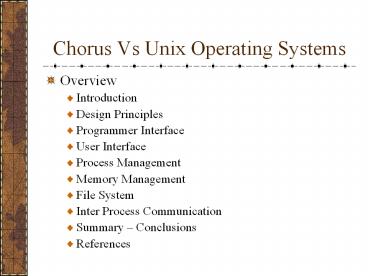Chorus Vs Unix Operating Systems - PowerPoint PPT Presentation
1 / 11
Title:
Chorus Vs Unix Operating Systems
Description:
The Chorus operating system is a highly scalable and reliable embedded operating ... The Unit of data abstraction in Chorus is called the segment. ... – PowerPoint PPT presentation
Number of Views:90
Avg rating:3.0/5.0
Title: Chorus Vs Unix Operating Systems
1
Chorus Vs Unix Operating Systems
- Overview
- Introduction
- Design Principles
- Programmer Interface
- User Interface
- Process Management
- Memory Management
- File System
- Inter Process Communication
- Summary Conclusions
- References
2
Introduction
- Unix Operating System
- Originally developed in a laboratory at ATTs
Bell Labs. - Unix is a mature, technically superior group of
operating systems with extremely powerful
multiprocessor server hardware. - Unix is a monolithic operating system.
- Chorus Operating System
- Chorus was a research project on distributed
systems at INIRA in France. It was bought by Sun
Microsystems in 1997. - The Chorus operating system is a highly scalable
and reliable embedded operating system. - Chorus is a micro kernel-based operating system.
3
Design Principles - Unix
- Unix is a layered operating system.
- The operating system, referred to in Unix as the
kernel, interacts with the hardware and provides
the services to the user programs. - It is a multi-user, multi-tasking operating
system.
4
Design Principle - Chorus
- A Chorus system is composed of a small nucleus
and a set of system servers, which cooperate in
the context of subsystems. - Chorus Nucleus is not the core of a specific
operating system rather it provides generic
tools designed to support a variety of host
subsystems, which can coexist on top of the
Nucleus. - This structure supports application programs,
which already run on an existing operating
system, by reproducing the operating systems
interface within a subsystem.
5
Process Management
- Unix
- Every process running under UNIX is identified by
a process- id (pid), an integer value. Each
process is identified with the owner of the
process, simply called uid. - Processes are arranged in a tree structure link.
- Unix is a timesharing system. Each turn is a
called a timeslice. - Chorus
- A process in Chorus defines a protected address
space. - Every process has a protection identifier
associated with it. - There are three kinds of processes in Chorus,
each having different execution privileges.
Supervisor processes, System processes and User
processes.
6
Memory Management
- Unix
- All memory assigned as pages
- Each user process works in a virtual 4GB memory
space - Multi-User nature of UNIX requires that no memory
be allocated to absolute locations - Unix memory management is based on Demand-paged
virtual memory system. - It employs the Least Recently Used algorithm.
7
Memory Management
- Chorus
- Abstract memory objects are typically provided to
protect regions of memory. Virtual memory
management may be implemented as part of the
kernel or user-level process. - The Unit of data abstraction in Chorus is called
the segment. Segments generally represent some
form of secondary storage such as a file. - Each process address space is divided into
regions. A region is a contiguous range of
virtual addresses within a process, which maps a
portion of a segment to a given virtual address.
- System processes known as mappers are responsible
for mapping segments onto regions. If a process
makes a request to read or modify data within a
region, the mapper returns the appropriate
segment containing the data.
8
File System
- Unix
- The UNIX file system is one of the simplest tree
structured file systems to use. - There are no syntax extensions for accessing
system files, files belonging to other users, or
files on network mounted file systems. - The file system is one place where UNIX has a
friendlier user interface than most systems. - Chorus
- The Chorus file system is very familiar to the
Unix file system but it provides a file manager. - The file manager acts as a mapper for the Chorus
kernel and also performs Unix file system
management. - The Chorus file system has the standard Unix
code, code to support Chorus segment mapper, and
codes to catch hardware interrupts and map them
onto hardware device drivers.
9
Inter-Process Communication
- Unix
- Processes in Unix based systems communicate
between themselves through IPC constructs. Among
these are - Pipes
- FIFO (named pipes)
- Streams (Files)
- Sockets
- Messages Exchange messages with any process or
server. - Semaphores Allow unrelated processes to
synchronize execution. - Shared memory Allow unrelated processes to share
memory. - Chorus
- Communication services provided by Chorus are
- Asynchronous Message-passing
- Does not guarantee delivery of message.
- No notification to sender.
- Synchronous RPC
- Client-Server model.
- Guarantees delivery of message.
- Notification send to sender
10
Protection and Security
- Unix
- Physical Security
- Network Security
- Account Security
- File System Security
- Chorus
- Security in Chorus is offered by the application
level. - There is no security in the Chorus nucleus.
- Chorus has provisions for the development of
secure distributed systems through support for
access control and authentication. - Security is offered in Chorus by the concept of
unique identifiers. - Knowledge of Unique Identifier gives full
privileges to manipulate the object.
11
Conclusion
- Unix cannot fulfill the expectations of system
builders if it continues to increase in
complexity without a well-defined modular
architecture, based on simple concepts, to manage
its growth. - Therefore micro-kernel based distributed
operating systems such as Chorus came into
existence.































